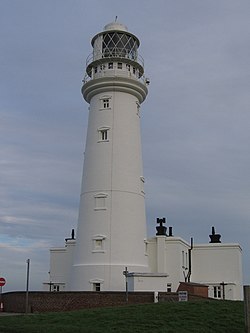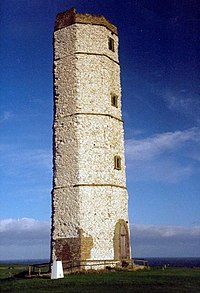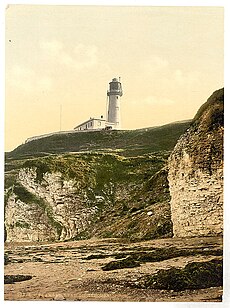Flamborough Head Lighthouse
| Flamborough Head Lighthouse | |
 Flamborough Head Lighthouse | |
|---|---|
| Location | |
| Grid reference: | TA25437065 |
| Location: | 54°6’59"N, 0°4’57"W |
| Characteristics | |
| Tower shape: | cylindrical tower with double balcony and lantern |
| Range: | 18 nautical miles |
| Light source: | LED |
| History | |
| Built 1806 | |
| First lit: | 1806 |
| Architect: | Samuel Wyatt |
| Information | |
Flamborough Head Lighthouse is an active lighthouse standing on Flamborough Head, close to Flamborough, in the East Riding of Yorkshire.
The lighthouse acts as a waypoint for passing deep sea vessels and coastal traffic, and is a seamark for Flamborough Head for vessels heading towards Scarborough and Bridlington.[1]
Old lighthouse
The first lighthouse, built by Sir John Clayton, was completed in 1674 and is one of the oldest surviving complete lighthouses in England. Built from chalk, it was never lit. This is now a Grade II* listed building.[2]
Current lighthouse
The present lighthouse, designed by Samuel Wyatt and costing £8,000 to build, was first lit on 1 December 1806. It had a distinctive light characteristic of two white flashes followed by a red flash. This was provided by the lighting apparatus, which was designed by optics specialist George Robinson, who was also Chief Inspector of Lighthouses at Trinity House. It consisted of a revolving vertical shaft with a three-sided frame on which were mounted 21 argand lamps, 7 on each side, with parabolic reflectors. On one of the three sides the reflectors were covered with red glass: this was the first use of red glass in a lighthouse and represented the first use of the colour as part of a light characteristic; the idea was soon taken up elsewhere. According to a description of the lighthouse written in 1818, the red light was used to distinguish Flamborough's lighthouse from the one at Cromer.[3] A Victorian pilot book used the mnemonic: 'Two whites to one red / Indicates Flambro' Head'.
In 1872, a new paraffin lamp was installed to the design of James Douglass.[4] Flamborough was the first Trinity House lighthouse to use paraffin, which had only lately been introduced as a lighthouse illuminant; afterwards, the Corporation upgraded all its oil burners to paraffin.
Along with the new lamp, a new first-order dioptric optic was installed, by Chance Brothers of Smethwick,[5] The revolving optic was designed to maintain the lighthouse's characteristic of two white flashes followed by one red flash; the speed of revolution was changed, however, from a flash every two minutes to a flash every 30 seconds.[6] Driven by clockwork, the optic was described at the time as 'a circular frame of six faces, composed of great glass prisms, [...] the third and sixth faces having sheets of ruby glass before them to give the red effect to the light'.[7] These red-flashing lenses were made more than double the width of the clear white-flashing panels, to compensate for the reduced intensity caused by the ruby filters;[8] with a width in azimuth of 69.5°, they were at the time the widest lens panels yet constructed.[9] The alterations cost £7,000 and provided a range of 21 nautical miles.[7] In 1907 the speed of rotation was increased, so as to give a flash every fifteen seconds.[10]
In 1925 the lantern was made taller, to accommodate a new 15-foot lens.[11] The lens is a large (first-order) revolving catadioptric optic made up of four asymmetrical panels; it displays four white flashes every fifteen seconds. (After the new lens was installed, the old apparatus was transferred to the Bahamas to be used as part of a programme of improvements to the lighthouses there.)[12] The light was converted from oil to electricity in 1940.
Following automation, the last lighthouse keepers left on 8 May 1996.[1] The light remains in use. The local council runs tours under licence from Trinity House.[13]
The lighthouse is a Grade II listed building.[14]
In 2022 the lighthouse was once again modernised: the revolving Fresnel optic was removed; it and the emergency light have been replaced by a pair of static LED lanterns.[15] As part of the modernisation programme the visible range of the light was reduced from 24 nautical miles to 18 nautical miles.[16]
Fog signal station
In 1859 a fog signal station was built (at some distance from the lighthouse, close to the cliff edge). Initially an 18-pound gun was used as the fog signal, sounded once every fifteen minutes.[17] A cottage was built within the compound as accommodation for the gunners.[18] In 1878, explosive rockets replaced the cannon,[19] discharged every 10 minutes in foggy weather (every five minutes from 1896)[20] and reaching an altitude of 600 feet.[1]
In 1908 an engine house was built next to the cottage and a fog siren replaced the rockets;[21] it sounded one long and one short blast, every 90 seconds, through a pair of Rayleigh trumpets mounted on the engine room roof.[22] Compressed air for the siren was provided by a pair of 22 hp Hornsby oil engines linked to a single-cylinder Hornsby compressor.[17]
In 1924 the siren was replaced by a pair of diaphones, mounted in a metal turret on top of a porch added to the front of the engine house.[23] This was itself superseded by an electric fog signal in 1975. In 2022 the signal was altered from two blasts to one long blast, every 90 seconds.[16]
The fog signal compound remains in Trinity House ownership; along with the modern fog signal apparatus, it has since 1998 accommodated a Differential Global Positioning System (DGPS) signal station.[24]
Outside links
| ("Wikimedia Commons" has material about Flamborough Head Lighthouse) |
References
- ↑ 1.0 1.1 1.2 Flamborough Head Lighthouse: Trinity House
- ↑ National Heritage List 1083400: The Old Lighthouse (Grade II* listing)
- ↑ Cotton, Joseph (1818). Memoir on the Origin and Incorporation of the Trinity House of Deptford Strond. London. p. 114. https://archive.org/details/memoironorigina00cottgoog.
- ↑ Elliot, George H. (1875). European Light-House Systems. London: Lockwood & co.. p. 70 n.3. http://access.bl.uk/item/pdf/lsidyv38f8413f. Retrieved 10 March 2019.
- ↑ Chance, James Frederick (1902). The Lighthouse Work of Sir James Chance, Baronet. London: Smith, Elder & co.. p. 118. https://uslhs.org/sites/default/files/attached-files/The%20Lighthouse%20Work%20of%20Sir%20James%20T.%20Chance.pdf. Retrieved 24 February 2019.
- ↑ "Monthly Abstract of Nautical Notices". The Nautical Magazine for 1872: 725. July 1872.
- ↑ 7.0 7.1 Chambers, William; Chambers, Robert (1885). Chambers's Journal of Popular Literature, Science and Arts (5th series, Vol. II, No. 85). W. & R. Chambers. p. 514.
- ↑ Elliot, George H. (1875). European Light-House Systems. London: Lockwood & co.. pp. 117–118. http://access.bl.uk/item/pdf/lsidyv38f8413f. Retrieved 10 March 2019.
- ↑ Littell, Eliakim; Littell, Robert S. (1887). "Lighthouse Work in the United Kingdom". The Living Age 174: 247.
- ↑ London Gazette, Issue 28030, Page 4102, 14 June 1907.
- ↑ "Flamborough Lighthouse at Flamborough Outer Headland". https://www.visithullandeastyorkshire.com/Bridlington-Flamborough-Lighthouse/details/?dms=3&venue=2172973.
- ↑ "Accounts and Papers: 1926 - General Lighthouse Fund". Parliamentary Papers 16: 8. 1926.
- ↑ "Flamborough Head Lighthouse visitor centre". Trinity House. https://www.trinityhouse.co.uk/lighthouse-visitor-centres/flamborough-lighthouse-visitor-centre.
- ↑ National Heritage List 1083399: The Lighthouse (Grade II listing)
- ↑ Wood, Alexandra (11 October 2022). "Sweeping beams of Flamborough Lighthouse have been replaced by static LED lights". Yorkshire Post. https://www.yorkshirepost.co.uk/news/people/sweeping-beams-of-flamborough-lighthouse-have-been-replaced-by-static-led-lights-3873873.
- ↑ 16.0 16.1 "Notice to Mariners, 30/08/2022: 31/2022 Flamborough Head Lighthouse". https://www.trinityhouse.co.uk/notice-to-mariners/31/2022-flamborough-head-lighthouse.
- ↑ 17.0 17.1 Renton, Alan (2001). Lost Sounds: The Story of Coast Fog Signals. Caithness, Scotland: Whittles.
- ↑ "Flamborough's lighthouses". http://www.flamborough-pc.gov.uk/Data/Sites/12/media/documents/flamboroughslighthouses.pdf.
- ↑ London Gazette, Issue 24540, Page 119, 8 January 1878.
- ↑ London Gazette, Issue 26757, Page 3981, 10 July 1896.
- ↑ London Gazette, Issue 28142, Page 4089, 2 June 1908.
- ↑ Photograph c.1910s
- ↑ photo (1928)
- ↑ Millyard, Simon (Winter 2015). "The new Differential Global Positioning System". Flash (24): 6. https://www.trinityhouse.co.uk/asset/1321/download?1457366075. Retrieved 21 March 2019.
| Lighthouses of Trinity House |
|---|
|
Great Britain: |
| Channel Islands and Gibraltar: Casquets • Europa Point • Les Hanois • Sark |



